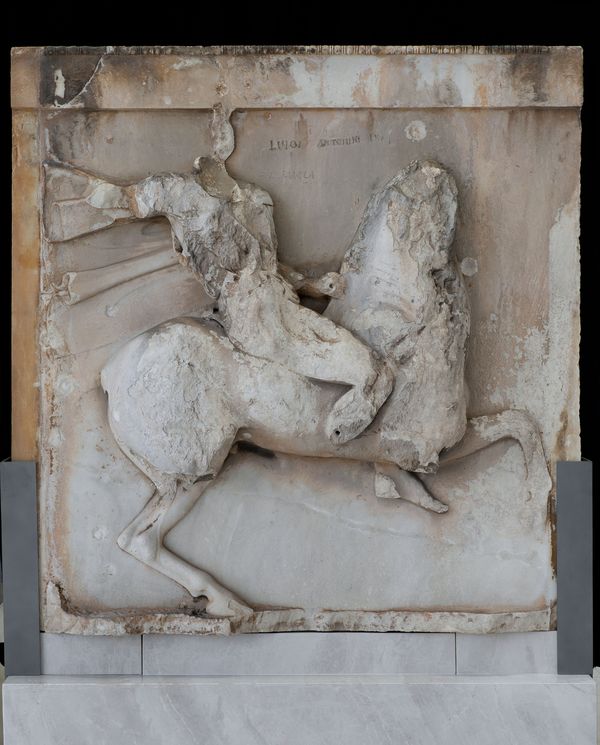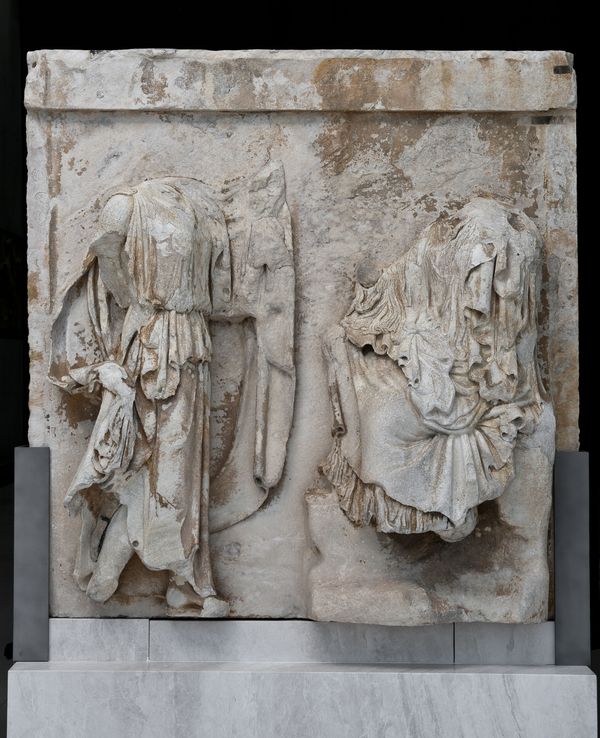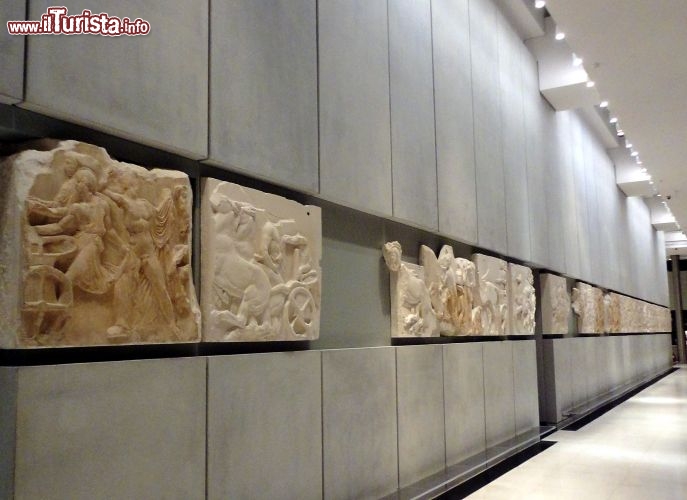
Parthenon. West metope 1 Acropolis Museum Official website
The Metopes of the Parthenon. The " Metopes of the Parthenon" are the surviving set of what initially had been 92 square carved plaques of marble. They were originally located above the columns of the Parthenon on the Acropolis of Athens. Typically each metope depicts two characters in combat. The Metopes were part of the relief sculptures.

British Museum Image gallery The Parthenon Sculptures
I due messaggeri olimpici Iris ed Hermes, sono visti dietro a proclamare la fine del concorso. Lo scultore del Partenone, metope e frontoni 5. A sinistra, il mitico re Cecrope e sua figlia assistono al concorso. Le figure semi-reclinate nelle due ali del frontone sono le personificazioni del fiume Kephisos e della sorgente di Calliroe.

France to lend Parthenon metope to Greece for 2021 celebrations
Marble metope from the Parthenon (South metope XXXII). This metope is from the eastern half of the south side of the temple. The South metopes in the British Museum show the battle between Centaurs and Lapiths at the marriage-feast of Peirithoos. A Centaur, on the left, grabs a Lapith while preparing to strike. The Centaur has seized the Lapith by the back of his head with his left hand. His.

Metopa del Partenón de Atenas ArteViajero
Le metope del Partenone sono i pannelli scultorei marmorei originariamente situati sulle pareti esterne del Partenone ad Atene, di cui costituivano parte del fregio. Storia. Originariamente erano novantadue: trentadue su ciascuno dei lati nord e sud e quattordici su ciascuna delle facciate principali del tempio, esposte ad est ed ovest..

Metopa
Metope del Partenone. Appunto di storia dell'arte antica che descrive in modo semplice e accurato le metope che costituiscono il Partenone. La decorazione esterna di un tempio era quasi sempre in.

Fidia; Amazonomachia; V secolo (447432) a.C.; bassorilievo in marmo
Romeo Castellucci Le Metope del Partenone. According to Romeo Castellucci, the Parthenon Friezes (Le Metope del Partenone) represent nothing else than "battles for life".In composing his own "stage friezes", the Italian director situates the piece in the context of an appalling accident, of unknown causes, and which has plunged its victim into a life and death situation.

Partenone Partenone, British museum, Arte greca
Metope south XXVII, Centaur and Lapith, British Museum. The metopes of the Parthenon are the surviving set of what were originally 92 square carved plaques of Pentelic marble originally located above the columns of the Parthenon peristyle on the Acropolis of Athens.If they were made by several artists, the master builder was certainly Phidias.They were carved between 447 or 446 BC. or at the.

Centauromachia nelle metope del Partenone, eseguita dai collaboratori
Le metope del lato sud — con l'eccezione di 13-20 metope piuttosto problematiche, ormai perdute — mostrano la Centauromachia Tessala. Sul lato nord del Partenone, le metope sono poco conservate, ma l'argomento sembra essere la Guerra di Troia.

Pediment and Metopes on Parthenon in Nashville, Tennessee Encircle Photos
Alternanza di metope e triglifi sul Partenone Metopa del Partenone raffigurante la lotta tra un Centauro e un Lapita. La mètopa è un elemento architettonico del fregio dell'ordine dorico dell'architettura greca e romana.Consiste in una formella in pietra, scolpita a rilievo, a seconda dei casi altorilievo o bassorilievo, posta in alternanza con i triglifi.

Exploring the Beauty of Metopes in Classical Architecture
Le metope del Partenone di Atene. Le metope furono eseguite per prime, in quanto dovevano essere poste assieme alla trabeazione. Sono 96 metope che misurano ciascuna 1,60 x 1.06 circa. Adornano l'intero fregio alternandosi ai triglifi e praticamente i temi trattati in qualche modo rimandano alla vittoria dei Greci contro i barbari Persiani.

Sculpture Saturday Metopes Of The Parthenon Salsaworldtraveler'sblog
Il tempio del Partenone - risalente al V secolo a.C. - che ancora oggi continua a dominare l'Acropoli della città, fu costruito in suo onore. Suo figlio adottivo Erittonio, uno dei primi re di Atene, viene tradizionalmente riconisciuto come l'inauguratore del Festival Panatenaico, tenuto ogni quattro anni in onore della dea.

Parthenon. North metope 32 Acropolis Museum Official website
Il colonnato del Partenone esterno presenta otto colonne sulle facciate e diciassette sui lati lunghi, quindi il loro rapporto è di 8:7. Lo spazio interno è occupato dalla cella, divisa in tre.

Resultado de imagen de metopas del partenon Arquitectura griega
Marble metope from the Parthenon (South Metope XXVIII). This metope is from the eastern half of the south side of the temple. The South Metopes in the British Museum show the battle between Centaurs and Lapiths at the marriage feast of Peirithoos. A Centaur rears triumphantly over a fallen Lapith. A feline skin hangs on the Centaur's extended left arm, the ends of the feline's skin flying.

Parthenon Metopes south XXVI the centaur rears up to strike the Lapith
Le metope del Partenone, il tempio costruito sull'Acropoli di Atene, sono 92. Ogni metopa è larga 1,25 m e alta 1,37 m ed erano applicate al fregio, alternate a triglifi. Le metope sono lastre quadrangolari che chiudevano gli spazi presenti tra una trave e l'altra. Erano poggiate sull'architrave e sostenevano il tetto che le sovrastava.

Metope del Partenone esposte al Museo dell'Acropoli Foto Atene
PDF | On Jan 1, 2013, Steven Nicastro published Il programma figurativo del Partenone: le metope | Find, read and cite all the research you need on ResearchGate

The metopes of the Parthenon in the northeast corner, Acropolis of
Partenone, particolare del fregio dorico, con le metope (rovinate) e i triglifi. In secondo piano si intravede il fregio ionico continuo che gira intorno alle pareti del naos.. Frederic Edwin Church, Colonne rotte del Partenone, 1869. New York, Cooper Hewitt Collection. Hubert Sattler, Rovine del Partenone, 1855. Olio su tela. Salzburg Museum.